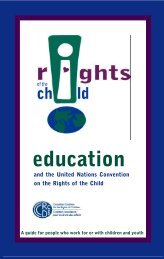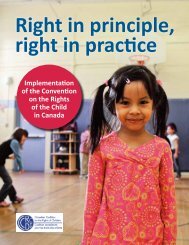Poste - Canadian Coalition for the Rights of Children
Poste - Canadian Coalition for the Rights of Children
Poste - Canadian Coalition for the Rights of Children
Create successful ePaper yourself
Turn your PDF publications into a flip-book with our unique Google optimized e-Paper software.
C A N A D I A N C O A L I T I O N F O R T H E R I G H T S O F C H I L D R E N<br />
It is difficult to determine <strong>the</strong> extent to which<br />
children’s fundamental freedoms are recognized and<br />
promoted in Canada, <strong>for</strong> <strong>the</strong>re is a critical lack <strong>of</strong><br />
accessible and reliable in<strong>for</strong>mation. However, rights<br />
education is not part <strong>of</strong> most schools’ core curricula<br />
and children’s Convention rights have not been<br />
widely promoted in Canada.<br />
To some extent, Canada upholds <strong>the</strong> Convention’s<br />
general principles <strong>of</strong> non-discrimination, best<br />
interests <strong>of</strong> <strong>the</strong> child, maximum survival and<br />
development, and respect <strong>for</strong> <strong>the</strong><br />
child’s views. School boards<br />
across <strong>the</strong> country promote<br />
multiculturalism, diversity and<br />
anti-discrimination; however,<br />
widespread homophobia<br />
among students is a<br />
recognized problem. In child<br />
welfare cases, <strong>the</strong> child’s<br />
best interests are weighed<br />
against parent’s rights. In<br />
o<strong>the</strong>r areas, children’s<br />
“best interests” are<br />
ignored or are interpreted<br />
without considering <strong>the</strong><br />
views <strong>of</strong> <strong>the</strong> children at<br />
all. The general<br />
principle <strong>of</strong> maximum<br />
survival and<br />
development is not<br />
assured <strong>for</strong> our most<br />
vulnerable children, such as<br />
children with disabilities, Aboriginal<br />
children and children in <strong>the</strong> care <strong>of</strong> <strong>the</strong> state.<br />
Jurisdictions<br />
Canada is a federation <strong>of</strong> 10 provinces and three<br />
territories. Where a child lives <strong>of</strong>ten determines <strong>the</strong><br />
degree to which his or her rights are met. There can<br />
be significant differences in <strong>the</strong> programs and services<br />
children receive in different parts <strong>of</strong> <strong>the</strong> country.<br />
Home care services <strong>for</strong> families with children with<br />
disabilities vary widely and <strong>the</strong>re is no ef<strong>for</strong>t to create<br />
standards or even to define basic services. Although<br />
I was looking in a store.<br />
The lady at <strong>the</strong> cashier<br />
asked my age and my<br />
sister’s, since we were<br />
toge<strong>the</strong>r at <strong>the</strong> time. I<br />
was 14 or 15 and my<br />
sister 12. The lady said,<br />
“Go away and come back<br />
with a parent.”<br />
— Tricia, aged 16<br />
4<br />
<strong>the</strong>re are no national standards <strong>for</strong> settlement services<br />
<strong>for</strong> refugees, <strong>the</strong> federal government is transferring<br />
authority <strong>for</strong> <strong>the</strong>se services to <strong>the</strong> provinces and<br />
territories. Child welfare services are <strong>of</strong>ten fragmented<br />
and uncoordinated within jurisdictions, with resources<br />
unevenly allocated across regions. For Aboriginal<br />
children living on reserves, <strong>the</strong> delivery <strong>of</strong> services is<br />
fur<strong>the</strong>r complicated by jurisdictional disputes.<br />
Research and Data<br />
There is little national in<strong>for</strong>mation about children in<br />
areas under provincial and territorial authority,<br />
as <strong>the</strong>re are extensive<br />
variations in <strong>the</strong> types <strong>of</strong><br />
data collected and <strong>the</strong><br />
manner in which <strong>the</strong>y are<br />
reported. For example,<br />
<strong>the</strong>re are no national<br />
statistics on child abuse<br />
and neglect in Canada and<br />
insufficient in<strong>for</strong>mation<br />
about how to prevent<br />
maltreatment. This lack <strong>of</strong><br />
in<strong>for</strong>mation on children<br />
constrains <strong>the</strong> development <strong>of</strong><br />
effective services. The federal<br />
government, <strong>for</strong> instance, does<br />
not collect statistics on <strong>the</strong><br />
number <strong>of</strong> child refugees who<br />
are held in detention. The most<br />
recent national study on children<br />
with disabilities was conducted in<br />
1991. Statistics and in<strong>for</strong>mation on<br />
<strong>Canadian</strong> <strong>for</strong>eign policy and programs <strong>for</strong> children are<br />
unclear and unreliable. There are no statistics on <strong>the</strong><br />
number <strong>of</strong> children with disabilities who file<br />
complaints with human rights commissions.<br />
Resources<br />
Resources <strong>for</strong> children’s programs and services are<br />
<strong>of</strong>ten stretched or unstable. Canada’s financial<br />
commitment to international aid has been dwindling.<br />
Cutbacks to education funding and <strong>the</strong> closing <strong>of</strong><br />
schools have undermined access to and quality <strong>of</strong>




